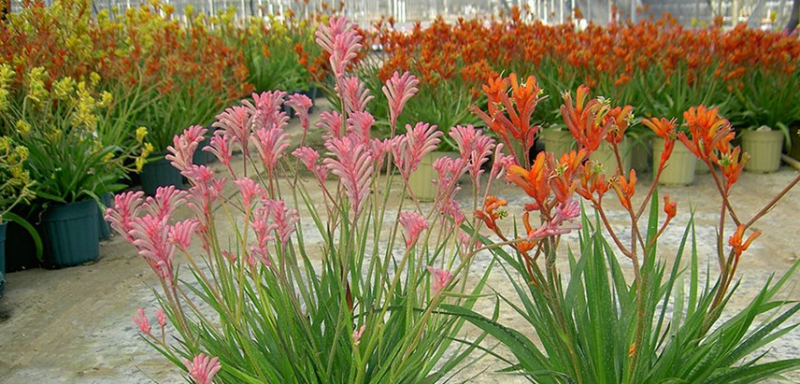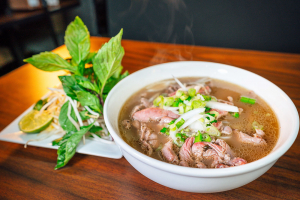Top 10 Most Popular Australian Plants
Australia has so many beautiful native plants that are a great choice for you. From the spectacular Waratah flower to the delicate Bluebells and even the ... read more...colorful Bottlebrush, there is no shortage of options when looking for an Australian native plants variety to add to your bouquet or garden! Below is a list of the most popular Australian plants, let's find out!
-
Banksia is a genus of around 170 species in the plant family Proteaceae. These well-known garden plants and native Australian flowers can be identified by their distinctive flower spikes, fruiting "cones", and heads. The size of a banksia can range from a small, woody shrub to a tree up to 30 meters (100 feet) tall. They can be found in a wide range of environments, including sclerophyll forests, (rarely) rainforests, shrubland, and some more dry ones, but not in Australia's deserts.
Banksias are a key component of the food chain in the Australian bush because they produce a lot of nectar. All kinds of nectarivorous creatures, such as birds, bats, rodents, possums, stingless bees, and a variety of invertebrates, rely on them as a major source of food. Additionally, they are crucial to Australia's cut flower and nursery businesses economically. However, a number of factors such as land clearing, frequent burning, and disease pose a threat to these plants, and several species are rare and endangered.

Wikipedia 
Gardening Know How -
Callistemon is a genus of shrubs in the family Myrtaceae, first described as a genus in 1814. The entire genus is endemic to Australia but widely cultivated in many other regions and naturalized in scattered locations. Many commercial nurseries continue to use the name ‘’Callistemon’’. These species can be propagated either by cuttings (some species more easily than others) or from the seeds.
Because of their cylindrical, brush-like blooms that resemble classic bottle brushes, Callistemon species are frequently referred to as bottle brushes. They are mainly found in Australia's temperate regions, particularly along the east coast. Because they normally like damp environments, they do best when planted in gardens where they receive frequent irrigation. But there are two species in Tasmania and many more in the southwest of Western Australia. At least some species can withstand dryness, and others are grown for ornamental landscaping in other parts of the world.

Plantura 
Burke's Backyard -
Eucalyptus globulus, commonly known as Southern Blue Gum or blue gum, is a species of tall, evergreen tree endemic to southeastern Australia. The Eucalyptus globulus tree normally reaches a height of 45 meters, but it can occasionally only be a stunted shrub. In addition, in perfect conditions, it can reach heights of 90 to 100 meters and produce a lignotuber. Usually white to cream in color and smooth, the bark might occasionally have stubborn, unshed slabs at the base. The stems of young plants, which can grow to heights of several meters, and coppice regrowth are more or less square in cross-section with a noticeable wing on each corner. Sessile, glaucous, elliptic to egg-shaped, up to 150 mm long and 105 mm wide, juvenile leaves are typically placed in opposite pairs.
The flower buds are grouped singly, in clusters of three or seven, or on a short, thick peduncle in the axils of the leaves. Additionally, the individual buds are typically sessile and occasionally on pedicels up to 5 mm long. Mature buds have a flattened hemispherical, warty operculum with a central knob and are top-shaped to conical, glaucous, or green. Subspecies and geographic distribution affect the flowering period, but white blooms are always present. The fruit is a woody, hemispherical or conical capsule with valves that are almost at rim level.

Gardening Know How 
Encyclopedia Britannica -
Grevillea Robusta, commonly known as the southern silky oak, silk oak or silky oak, silver oak, or Australian silver oak, is a flowering plant in the family Proteaceae. It is a tree, the largest species in its genus but is not closely related to the true oaks, Quercus. It is a native of eastern coastal Australia, growing in riverine, subtropical, and dry rainforest environments.
Grevillea robusta is an evergreen tree with a single main trunk that grows quickly and can reach heights of 5 to 40 meters. The bark is wrinkled and dark grey. Its fern-like leaves are between 10 and 34 cm in length, 9 to 15 cm in width, and have between 11 and 31 primary lobes. Sometimes there are as many as four additional lobes that are each linear to narrowly triangular in shape. Just before blossoming, several of its leaves are lost. The blooms are grouped in one-sided, "toothbrush"-like groupings that are 12 to 15 cm long and occasionally branching. Each flower's female component, the carpel, has a stalk that is 21–28 mm long. The glabrous flowers are primarily yellowish orange, though occasionally they can be scarlet. From September through November, there is flowering, and a glabrous follicle is a fruit that results.

Trees and Shrubs Online 
GardensOnline -
Hakea is a genus of about 150 species of plants in the Family Proteaceae, endemic to Australia. In many areas of Australia, hakeas are just as prevalent as grevilleas and banksias as decorative plants in gardens. There have been several hybrids and cultivars created, notably Hakea 'Burrendong Beauty'. They thrive in light soil beds that are watered but still have good drainage.
Shrubs or tiny trees make up the Hakea genus of plants. Some species have flat leaves, while others have needle-like leaves that occasionally are split and occasionally have a groove on the underside. When in the bud, the flowers are grouped in groups on the leaf axils and are encircled by bracts. The flowers are carried on a slender stalk known as a pedicel and have both male and female parts. As the flower grows, the sepals and petals, collectively known as tepals, form a curved tube that occasionally rips open. The style is bent before its tip is released and is longer than the tepal tube. When released, the tip of the style is a pollen-presenter.

Wikipedia 
iStock -
Kangaroo Paw is the common name for a number of species, in two genera of the family Haemodoraceae, that are native to southwest Western Australia. These rhizomatous perennial plants are well-known for their distinctive blossoms that draw birds. The popular name "kangaroo paw" comes from the tubular blooms' six claw-like appendages that open at the apex of the flower, which is covered in dense hairs. The kangaroo paw plant has been introduced into Japan and has been grown as a new ornamental crop mainly on Okinawa Island under a subtropical climate.
Kangaroo paws now come in a variety of new hues thanks to research conducted in the years leading up to 2020, including blues, purples, whites, and many others. To comprehend the flower's colors, genetic study and DNA sequencing comparable to that done on Snapdragons have been conducted. According to another study, the plant's spores may help rejuvenate and restore skin firmness by increasing the collagen produced by the source's young cells.

Costa Farms 
Australia - LoveToKnow -
Lantana is a genus of about 150 species of perennial flowering plants in the verbena family, Verbenaceae. They are indigenous to the tropics of the Americas and Africa, but they have been brought to many other locations, including the Australian-Pacific region and the south and northeastern parts of India. The genus contains both shrubs and herbaceous plants that can reach heights of 0.5-2 m (1.6-6.6 ft). Their popular names are lantanas or shrub verbenas. The generic name was first used in Late Latin to describe a separate plant called Viburnum lantana.
Red, orange, yellow, blue, or white florets are mixed together in the umbels, which are scented flower clusters on lantana plants. Since new types are being chosen, additional hues exist. Inflorescences with two or three colors are produced as a result of the flowers' usual color changes as they get older. "Wild lantanas" are plants of the unrelated genus Abronia, usually called "sand-verbenas".

Wikipedia 
The Spruce -
Waratah (Telopea) is an Australian-endemic genus of five species of large shrubs or small trees, native to the southeastern parts of Australia (New South Wales, Victoria, and Tasmania). The most well-known member of this genus is Telopea speciosissima, which is the state flower of New South Wales and features vivid red blossoms. The Waratah is a flowering plant found in the Southern Hemisphere that belongs to the Proteaceae family. Being a pyrogenic flowering species, they favor sandy loam soils and depend on post-fire flowering, followed by the formation and dissemination of latent seeds, to benefit from favorable growing circumstances in the altered environment that results from a fire.
The inflorescence, which is frequently very large, vividly colored, and showy and is composed of several tiny flowers densely packed into a compact head or spike, is the primary distinguishing feature of Proteaceae. Waratah species have inflorescences with a basal ring of colored bracts that are between 6 and 15 cm in diameter. The leaves are 10–20 cm long, 2-3 cm wide, and have whole or serrated margins. They are grouped spirally. The Eora Aboriginal people, who lived in the Sydney region before the arrival of the Europeans, gave the waratah its name.

Wikipedia 
The Conversation -
Acacia pycnantha, most commonly known as the Golden Wattle, is a tree of the family Fabaceae native to southeastern Australia. It bears phyllodes (flattened leaf stalks) instead of real leaves and can reach a height of 8 m (26 ft). These are scythe-shaped and range in length from 9 to 15 cm and width from 1 to 3.5 cm. Late winter and early spring see the appearance of numerous fragrant, golden blossoms, followed by lengthy seed pods. Several species of thornbill and honeyeater visit the nectaries on the phyllodes of plants and brush against the flowers, spreading pollen between them as they do so.
The original specimen was collected by explorer Thomas Mitchell, from which George Bentham derived the species description in 1842. There are no recognized subspecies. A. pycnantha is cultivated commercially to make tannin because its bark produces more tannin than any other wattle species. It has been widely cultivated for decorative gardens and the production of cut flowers, but in South Africa, Tanzania, Italy, Portugal, Sardinia, India, Indonesia, New Zealand, as well as Western Australia, Tasmania, and New South Wales, it has turned into a weed. In 1988, Acacia pycnantha was designated as Australia's official floral symbol and has since appeared on its postage stamps.

Wikipedia 
Particle - Scitech -
Leptospermum lanigerum, commonly known as the Woolly Teatree, is a small tree or medium shrub from the plant family Myrtaceae. The prominently hairy fruit capsules and the fine, silky hairs on the branches and leaves are the sources of the plant's popular name. L. lanigerum is common throughout a variety of habitats, but it is most prevalent in wet regions like moist, sandy coastal heaths, on riverbanks, riparian scrub, forests, and on the edge of montane grasslands.
Leptospermum flowers typically have five free, white petals, many stamens, and five tiny sepals, but their most noticeable qualities are their persistent hairy capsules and their mature foliage's silvery look. In Australia, L. lanigerum is ubiquitous and prevalent, occurring in both native populations and cultivated forms. Indigenous Australians have long utilized this species, which is now a well-liked garden plant.

Wikipedia 
Cloud Mountain Farm































